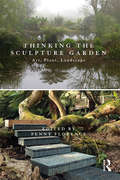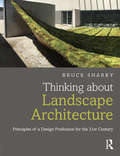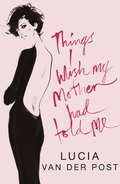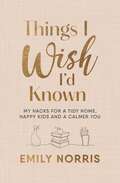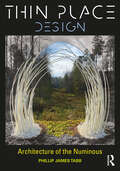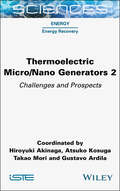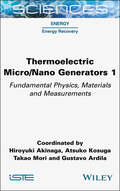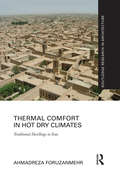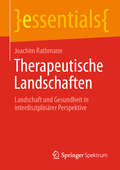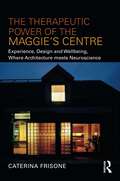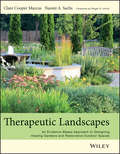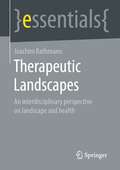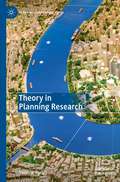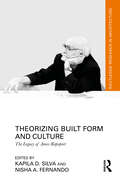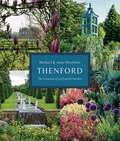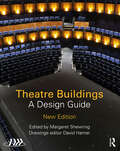- Table View
- List View
Thinking the Sculpture Garden: Art, Plant, Landscape
by Penny FlorenceThis innovative book poses two, deceptively simple, questions: what is a sculpture garden, and what happens when you give equal weight to the main elements of landscape, planting and artwork? Its wide-ranging frame of reference, including the USA, Europe and Japan, is brought into focus through Tremenheere Sculpture Garden, Cornwall, with which the book begins and ends. Effectively less than 15 years old, and largely the work of one man, Tremenheere affords an opportunity to examine as work-in-progress the creation of a new kind of sculpture garden. Including a historical overview, the book traverses multiple ways of seeing and experiencing sculpture gardens, culminating in an exploration of their relevance as 'cultural ecology' in the context of globalisation, urbanisation and climate change. The thinking here is non-dualist and broadly aligned with New Materialisms and Material Feminisms to explore our place as humans in the non-human world on which we depend. Eminent contributors, including John Dixon Hunt, George Descombes, Bernard Lassus and David Leatherbarrow, approach these issues through practices and theories of landscape architecture; garden and art making; history and writing; and philosophy. Richly illustrated with over 100 images, including a colour plate section, the book will primarily appeal to those engaged in professional or academic research, along with sculpture garden visitors, who will find new and surprising ways of experiencing plants and art in natural and urban settings.
Thinking about Landscape Architecture: Principles of a Design Profession for the 21st Century
by Bruce SharkyWhat is landscape architecture? Is it gardening, or science, or art? In this book, Bruce Sharky provides a complete overview of the discipline to provide those that are new to the subject with the foundations for future study and practice. The many varieties of landscape practice are discussed with an emphasis on the significant contributions that landscape architects have made across the world in daily practice.? Written by a leading scholar and practitioner, this book outlines the subject and explores how, from a basis in garden design, it 'leapt over the garden wall' to encapsulate areas such as urban and park design, community and regional planning, habitat restoration, green infrastructure and sustainable design, and site engineering and implementation. Coverage includes: The effects that natural and human factors have upon design, and how the discipline is uniquely placed to address these challenges? Examples of contemporary landscape architecture work - from storm water management and walkable cities to well-known projects like the New York High Line and the London Olympic Park? Exploration of how art and design, science, horticulture, and construction come together in one subject? Thinking about Landscape Architecture is perfect for those wanting to better understand this fascinating subject, and those starting out as landscape architecture students.
Thinking about Landscape Architecture: Principles of a Design Profession for the 21st Century
by Bruce SharkyWhat is landscape architecture? Is it gardening, or science, or art? In this book, Bruce Sharky provides a complete overview of the discipline to provide those that are new to the subject with the foundations for future study and practice. The many varieties of landscape practice are discussed with an emphasis on the significant contributions that landscape architects have made across the world in daily practice.? Written by a leading scholar and practitioner, this book outlines the subject and explores how, from a basis in garden design, it 'leapt over the garden wall' to encapsulate areas such as urban and park design, community and regional planning, habitat restoration, green infrastructure and sustainable design, and site engineering and implementation. Coverage includes: The effects that natural and human factors have upon design, and how the discipline is uniquely placed to address these challenges? Examples of contemporary landscape architecture work - from storm water management and walkable cities to well-known projects like the New York High Line and the London Olympic Park? Exploration of how art and design, science, horticulture, and construction come together in one subject? Thinking about Landscape Architecture is perfect for those wanting to better understand this fascinating subject, and those starting out as landscape architecture students.
Things I Wish My Mother Had Told Me: Lessons in Grace and Elegance
by Lucia Van Der PostPacked full of golden rules from one of Britain's most stylish women, Things I Wish My Mother Had Told Me is a woman's companion for life. Lucia van der Post reveals the secrets of dressing stylishly with advice on everything from how to organise your wardrobe, what to wear to travel and where to buy delicious underwear, great cashmere and sassy skirts. Practical health and beauty tips will help you to choose a sophisticated scent, get fitter and decide whether cosmetic surgery is for you.Once you've mastered looking fantastic, learn how to add some elegance to other areas of your life. Discover great shortcuts to entertaining your guests as well as suggestions, from designers around the world, on how to make your home match the elegant new you. With advice on relationships, motherhood and how to juggle work, love and children, this is the essential handbook for women of all ages. Whether you are just starting out in life or want to age gracefully and make 60 the new 40, let Lucia van der Post guide you towards a new life and a new you with a touch of style.
Things I Wish I’d Known: My hacks for a tidy home, happy kids and a calmer you
by Emily Norris'Queen of the mothering hack. Emily Norris delivers ingenious ideas to make life a little bit easier!’ – Giovanna Fletcher, bestselling author and podcaster'Genius hacks to save time and bring a little more joy' – Anna Mathur, Psychotherapist and bestselling author'Packed with tips and ideas that make mum life *just* a little easier!' – Harriet Shearsmith, @tobyandrooI became obsessed with mum hacks when a friend showed me a game-changing tip during my baby days - that baby vests can be pulled down (not up) in the event of an explosive poo. I couldn't believe I had been a mum for so long and not known! Things I Wish I'd Known will bring you hundreds of quick and clever solutions, just like this, all to make the parenting juggle easier.You'll find my favourite hacks and habits, as well as dozens of new ones, all designed to give your day-to-day a lift. From cleaning hacks that leave your home sparkling in no time, laundry tricks that save you money, and simple tweaks to night-time routines which transform everyone's sleep, I'll show you how to hack every aspect of home-life so you feel less stress and more joy!Emily x
Thin Place Design: Architecture of the Numinous
by Phillip James TabbWhat makes the places we inhabit extraordinary? Why are some urban spaces more vital and restorative? Wonderful landscapes, inspiring works of architecture and urban design, and the numinous experiences that accompany them have been an integral dimension of our culture. Up-lifting spaces, dramatic use of natural light, harmonic proportional geometry, magical landscapes, historic sites and vital city centers create special, even sacred moments in architecture and planning. This quality of experience is often seen as an aesthetic purpose intended to inspire, ennoble, ensoul and spiritually renew. Architecture and urban spaces, functioning in this way, are considered to be thin places.
Thin Place Design: Architecture of the Numinous
by Phillip James TabbWhat makes the places we inhabit extraordinary? Why are some urban spaces more vital and restorative? Wonderful landscapes, inspiring works of architecture and urban design, and the numinous experiences that accompany them have been an integral dimension of our culture. Up-lifting spaces, dramatic use of natural light, harmonic proportional geometry, magical landscapes, historic sites and vital city centers create special, even sacred moments in architecture and planning. This quality of experience is often seen as an aesthetic purpose intended to inspire, ennoble, ensoul and spiritually renew. Architecture and urban spaces, functioning in this way, are considered to be thin places.
Thermoelectric Micro / Nano Generators, Volume 2: Challenges and Prospects
by Hiroyuki Akinaga Atsuko Kosuga Takao Mori Gustavo ArdilaThis book explores a key technology regarding the importance of connections via an Internet of Things network and how this helps us to easily communicate with others and gather information. Namely, what would happen if this suddenly became unavailable due to a shortage of power or electricity? Using thermoelectric generators is a viable solution as they use the heat around us to generate the much-needed electricity for our technological needs. This second volume on the challenges and prospects of thermoelectric generators covers the reliability and durability of thermoelectric materials and devices, the effect of microstructures on the understanding of electronic properties of complex materials, thermoelectric nanowires, the impact of chemical doping or magnetism, thermoelectric generation using the anomalous Nernst effect, phonon engineering, the current state and future prospects of thermoelectric technologies, transition metal silicides, and past, present and future applications of thermoelectrics.
Thermoelectric Micro / Nano Generators, Volume 2: Challenges and Prospects
by Hiroyuki Akinaga Atsuko Kosuga Takao Mori Gustavo Adolfo Ardila RodriguezThis book explores a key technology regarding the importance of connections via an Internet of Things network and how this helps us to easily communicate with others and gather information. Namely, what would happen if this suddenly became unavailable due to a shortage of power or electricity? Using thermoelectric generators is a viable solution as they use the heat around us to generate the much-needed electricity for our technological needs. This second volume on the challenges and prospects of thermoelectric generators covers the reliability and durability of thermoelectric materials and devices, the effect of microstructures on the understanding of electronic properties of complex materials, thermoelectric nanowires, the impact of chemical doping or magnetism, thermoelectric generation using the anomalous Nernst effect, phonon engineering, the current state and future prospects of thermoelectric technologies, transition metal silicides, and past, present and future applications of thermoelectrics.
Thermoelectric Micro / Nano Generators, Volume 1: Fundamental Physics, Materials and Measurements
by Hiroyuki Akinaga Atsuko Kosuga Takao Mori Gustavo ArdilaThis book explores a key technology regarding the importance of connections via an Internet of Things network and how this helps us to easily communicate with others and gather information. Namely, what would happen if this suddenly became unavailable due to a shortage of power or electricity? Using thermoelectric generators is a viable solution as they use the heat around us to generate the much-needed electricity for our technological needs. This first volume explores the computational and data-driven development of these thermoelectric generators, as well as the use of various abundant materials such as copper and silver chalcogenides and nanocarbons. It also offers reviews on universal property enhancement principles and the case of strongly correlated oxides, and goes on to explore the metrology of the thermal properties of thermoelectric generators, detailing methods of how to measure the absolute Seebeck coefficient using the Thomson effect and the thermal diffusivity of thin films using the ultrafast laser flash method.
Thermoelectric Micro / Nano Generators, Volume 1: Fundamental Physics, Materials and Measurements
by Hiroyuki Akinaga Atsuko Kosuga Takao Mori Gustavo Adolfo Ardila RodriguezThis book explores a key technology regarding the importance of connections via an Internet of Things network and how this helps us to easily communicate with others and gather information. Namely, what would happen if this suddenly became unavailable due to a shortage of power or electricity? Using thermoelectric generators is a viable solution as they use the heat around us to generate the much-needed electricity for our technological needs. This first volume explores the computational and data-driven development of these thermoelectric generators, as well as the use of various abundant materials such as copper and silver chalcogenides and nanocarbons. It also offers reviews on universal property enhancement principles and the case of strongly correlated oxides, and goes on to explore the metrology of the thermal properties of thermoelectric generators, detailing methods of how to measure the absolute Seebeck coefficient using the Thomson effect and the thermal diffusivity of thin films using the ultrafast laser flash method.
Thermal Comfort in Hot Dry Climates: Traditional Dwellings in Iran (Routledge Research in Architecture)
by Ahmadreza ForuzanmehrWith increases in global temperatures, the risk of overheating is expected to rise around the world. This results in a much higher dependency upon energy-intensive cooling systems and air-conditioners to provide thermal comfort, but how sustainable is this in a world where problems with the production of electricity are predicted? Vernacular houses in hot and dry central Iran have been adapted to the climate through passive cooling techniques, and this book provides a valuable assessment of the thermal performance of such housing. Shedding new light on the ability of traditional housing forms to provide thermal comfort, Thermal Comfort in Hot Dry Climates identifies the main cooling systems and methods in traditional houses in central Iran, and examines how architectural elements such as central courtyards, distinct seasonal rooms, loggias, basements and wind-catchers can contribute to the provision of thermal comfort in vernacular houses.
Thermal Comfort in Hot Dry Climates: Traditional Dwellings in Iran (Routledge Research in Architecture)
by Ahmadreza ForuzanmehrWith increases in global temperatures, the risk of overheating is expected to rise around the world. This results in a much higher dependency upon energy-intensive cooling systems and air-conditioners to provide thermal comfort, but how sustainable is this in a world where problems with the production of electricity are predicted? Vernacular houses in hot and dry central Iran have been adapted to the climate through passive cooling techniques, and this book provides a valuable assessment of the thermal performance of such housing. Shedding new light on the ability of traditional housing forms to provide thermal comfort, Thermal Comfort in Hot Dry Climates identifies the main cooling systems and methods in traditional houses in central Iran, and examines how architectural elements such as central courtyards, distinct seasonal rooms, loggias, basements and wind-catchers can contribute to the provision of thermal comfort in vernacular houses.
Therapeutische Landschaften: Landschaft und Gesundheit in interdisziplinärer Perspektive (essentials)
by Joachim RathmannJoachim Rathmann stellt die interdisziplinären Bezüge von Landschaften und Gesundheit dar. Die Natur ist als elementare Gesundheitsressource zu betrachten, denn Bewegung in naturnaher Umgebung hat nachweislich positive Einflüsse auf die menschliche Gesundheit und wird im Konzept der „Therapeutischen Landschaften“ vielfältig zusammengefasst. Naturräume bieten vor allem einer älter werdenden Gesellschaft eine wichtige, auch ökonomisch messbare Ressource für die Stärkung von Gesundheit. Der Autor bereitet natur-, sozial,- und geisteswissenschaftliche Untersuchungen für eine breit gefächerte Leserschaft verständlich, anschaulich und übersichtlich auf. Gleichzeitig gibt er Anregungen für einen bewussten Umgang mit der sensiblen Ressource Landschaft und zu einer regelmäßigen Naturbeobachtung.
The Therapeutic Power of the Maggie’s Centre: Experience, Design and Wellbeing, Where Architecture meets Neuroscience
by Caterina FrisoneThis book is about the therapeutic environment of the Maggie’s centre and explores the many ways this is achieved. With an unconventional architecture as required by the design brief, combined with Maggie’s psychological support programme, this special health facility allows extraordinary therapeutic effects in people, to the point that one can speak of therapeutic power.After tracing the story of the Maggie’s centre, the book reveals its fundamentals: Maggie’s Therapeutikos (the-mind-as-important-as-the-body), the Architectural Brief and the ‘Client-Architect-Users’ Triad. It continues by unfolding Maggie’s synergy-that between people and place-which increases users’ psychological flexibility helping them tolerate what was intolerable before. Although comfort and atmospheres are paramount, they are not enough to define the therapeutic environment of the Maggie’s centre. Only by looking at neuroscience that can give us scientific explanations of empathy, feelings and emotions and only considering space neither neutral nor empty, but full of forces that envelop people in an embodied experience, can we explain what generates wellbeing in a Maggie’s centre.The book concludes by critically evaluating the Maggie’s centre as a model to be applied to other healthcare facilities and to architecture in general. It is essential reading for any student or professional working on therapeutic environments.
The Therapeutic Power of the Maggie’s Centre: Experience, Design and Wellbeing, Where Architecture meets Neuroscience
by Caterina FrisoneThis book is about the therapeutic environment of the Maggie’s centre and explores the many ways this is achieved. With an unconventional architecture as required by the design brief, combined with Maggie’s psychological support programme, this special health facility allows extraordinary therapeutic effects in people, to the point that one can speak of therapeutic power.After tracing the story of the Maggie’s centre, the book reveals its fundamentals: Maggie’s Therapeutikos (the-mind-as-important-as-the-body), the Architectural Brief and the ‘Client-Architect-Users’ Triad. It continues by unfolding Maggie’s synergy-that between people and place-which increases users’ psychological flexibility helping them tolerate what was intolerable before. Although comfort and atmospheres are paramount, they are not enough to define the therapeutic environment of the Maggie’s centre. Only by looking at neuroscience that can give us scientific explanations of empathy, feelings and emotions and only considering space neither neutral nor empty, but full of forces that envelop people in an embodied experience, can we explain what generates wellbeing in a Maggie’s centre.The book concludes by critically evaluating the Maggie’s centre as a model to be applied to other healthcare facilities and to architecture in general. It is essential reading for any student or professional working on therapeutic environments.
Therapeutic Landscapes: An Evidence-Based Approach to Designing Healing Gardens and Restorative Outdoor Spaces
by Clare Cooper Marcus Naomi A SachsThis comprehensive and authoritative guide offers an evidence-based overview of healing gardens and therapeutic landscapes from planning to post-occupancy evaluation. It provides general guidelines for designers and other stakeholders in a variety of projects, as well as patient-specific guidelines covering twelve categories ranging from burn patients, psychiatric patients, to hospice and Alzheimer's patients, among others. Sections on participatory design and funding offer valuable guidance to the entire team, not just designers, while a planting and maintenance chapter gives critical information to ensure that safety, longevity, and budgetary concerns are addressed.
Therapeutic Landscapes: An Evidence-Based Approach to Designing Healing Gardens and Restorative Outdoor Spaces
by Clare Cooper Marcus Naomi A SachsThis comprehensive and authoritative guide offers an evidence-based overview of healing gardens and therapeutic landscapes from planning to post-occupancy evaluation. It provides general guidelines for designers and other stakeholders in a variety of projects, as well as patient-specific guidelines covering twelve categories ranging from burn patients, psychiatric patients, to hospice and Alzheimer's patients, among others. Sections on participatory design and funding offer valuable guidance to the entire team, not just designers, while a planting and maintenance chapter gives critical information to ensure that safety, longevity, and budgetary concerns are addressed.
Therapeutic Landscapes: An Interdisciplinary Perspective on Landscape and Health (essentials)
by Joachim RathmannJoachim Rathmann presents the interdisciplinary relationships between landscapes and health. Nature is to be regarded as an elementary health resource, because movement in near-natural surroundings has demonstrably positive influences on human health and is summarized in many ways in the concept of "therapeutic landscapes". Natural areas offer an important resource for strengthening health, especially to an aging society, which can also be measured economically. The author presents natural science, social science, and humanities research in a clear, understandable, and concise manner for a broad readership. At the same time he gives suggestions for a conscious handling of the sensitive resource landscape and for a regular observation of nature. This springer essential is a translation of the original German 1st edition essentials,Therapeutic landscapes by Joachim Rathmann, published by Springer Fachmedien Wiesbaden GmbH, part of Springer Nature in 2020.The translation was done with the help of artificial intelligence (machine translation by the service DeepL.com). A subsequent human revision was done primarily in terms of content, so that the book will read stylistically differently from a conventional translation. Springer Nature works continuously to further the development of tools for the production of books and on the related technologies to support the authors.
Theory in Planning Research (Planning, Environment, Cities)
by Yvonne RydinDoing research is an essential element of almost all programmes in planning studies as well as related areas such as geography and urban studies, from undergraduate, through Masters to doctoral programmes. While most texts on such research emphasise methodologies, this book is unique in addressing how theoretical frameworks and perspectives can inform research activity. Providing both a concise introduction to a wide range of such theories and detailed engagement with cases of planning research, it provides the reader with the insights necessary to conduct theory-informed research. It offers an understanding of how the choice of a theoretical framework has implications for the focus of the research, the precise research questions addressed and the methodologies that will be most effective in answering those questions. Through practical advice and published examples it will support planning researchers in doing stronger, more widely-applicable research, which answers key questions about planning systems and their role within our societies.
Theorizing Built Form and Culture: The Legacy of Amos Rapoport (Routledge Research in Architecture)
by Kapila D. Silva Nisha A. FernandoIn this collection of essays, Theorizing Built Form and Culture: The Legacy of Amos Rapoport – a felicitation volume to celebrate the significance of Professor Amos Rapoport's lifelong scholarship – scholars from around the world discuss the analytical relevance, expansion, and continuing application of these contributions in developing an advanced understanding of mutual relationships between people and built environments across cultures.Professor Amos Rapoport has espoused an intellectual and theoretical legacy on environmental design scholarship that explains how cultural factors play a significant role in the ways people create and use environments as well as the way environments, in turn, influence people’s behavior. This volume presents a hitherto-not-seen, unique, and singular work that simultaneously articulates a cohesive framework of Rapoport’s architectural theories and demonstrates how that theoretical approach be used in architectural inquiry, education, and practice across environmental scales, types, and cultural contexts. It also acknowledges, for the very first time, how this theoretical legacy has pioneered the decolonizing of the Eurocentric approaches to architectural inquiry and has thus privileged an inclusive, cross-cultural perspective that laid the groundwork to understand and analyze non-Western design traditions. The book thus reflects a wide range of cross-cultural and cross-contextual range to which Professor Rapoport’s theories apply, a general notion of theoretical validity he always advocated for in his own writings.The volume is a paramount source for scholars and students of architecture who are interested in understanding how culture mediates the creation, use, and preservation of the built environment.
Theorizing Built Form and Culture: The Legacy of Amos Rapoport (Routledge Research in Architecture)
In this collection of essays, Theorizing Built Form and Culture: The Legacy of Amos Rapoport – a felicitation volume to celebrate the significance of Professor Amos Rapoport's lifelong scholarship – scholars from around the world discuss the analytical relevance, expansion, and continuing application of these contributions in developing an advanced understanding of mutual relationships between people and built environments across cultures.Professor Amos Rapoport has espoused an intellectual and theoretical legacy on environmental design scholarship that explains how cultural factors play a significant role in the ways people create and use environments as well as the way environments, in turn, influence people’s behavior. This volume presents a hitherto-not-seen, unique, and singular work that simultaneously articulates a cohesive framework of Rapoport’s architectural theories and demonstrates how that theoretical approach be used in architectural inquiry, education, and practice across environmental scales, types, and cultural contexts. It also acknowledges, for the very first time, how this theoretical legacy has pioneered the decolonizing of the Eurocentric approaches to architectural inquiry and has thus privileged an inclusive, cross-cultural perspective that laid the groundwork to understand and analyze non-Western design traditions. The book thus reflects a wide range of cross-cultural and cross-contextual range to which Professor Rapoport’s theories apply, a general notion of theoretical validity he always advocated for in his own writings.The volume is a paramount source for scholars and students of architecture who are interested in understanding how culture mediates the creation, use, and preservation of the built environment.
Thenford: The Creation of an English Garden
by Anne Heseltine Michael HeseltineThis book is the story of one garden and one family, over a 40-year time period. In their own words, Michael and Anne Heseltine describe the ups and downs of how they set about transforming and expanding a wild, overgrown and often dilapidated woodland into the magnificent garden they have today. Today, the garden at Thenford has an arboretum which contains more than 3,500 different species of trees and shrubs, including rare plants which were wild-collected by well known plantsmen including Roy Lancaster OBE, Allen Coombes, Keith Rushforth and Chris Chadwell. It is also well-known for its sculpture garden, which has an eclectic collection of work ranging from a white marble Tazza fountain to an enormous statue of Lenin. Beautifully illustrated with both professional photographs and private family images, this personal story of the creation of an extraordinary garden will delight horticultural experts and novices alike.
Theatre Buildings: A Design Guide
by Association of British Theatre Technicians (ABTT) Margaret ShewringIn 2021, its Diamond Jubilee year, the Association of British Theatre Technicians (ABTT) undertook to revise Theatre Buildings: A Design Guide (Routledge, 2010). This new edition (Routledge, 2023) has substantially re-written text with fresh images and entirely new reference projects, providing essential guidance for all those engaged in the design of theatre buildings. Edited by Margaret Shewring (Emeritus Reader, University of Warwick, former Director of the Postgraduate Diploma and MA in Theatre Consultancy), this new publication is written by a team of international experts, architects, theatre consultants, acousticians, engineers and industry professionals led by Tim Foster (Foster Wilson Size) and Robin Townley (CEO of the ABTT). It provides an invaluable resource for those looking to build, remodel or conserve theatre buildings, taking into account the significant changes which have taken place in the last twelve years in all aspects of theatre design and technical practice. It locates those changes in the wider context of the need for sustainability in the theatre industry in response to the climate emergency, inclusivity, diversity of access, placemaking and concerns for health and wellbeing. This new edition provides guidance for anyone who seeks inspiration and encouragement to create or improve a place of entertainment or who seeks to understand what might be required to accommodate an audience for the presentation of live performance and the successful use, operation and organisation of such a venue. Its generous format and the thirty-two new reference projects, more than 260 high-resolution colour images and 175 diagrams and specially commissioned plans make it accessible and informative both to the general reader and the professional specialist.
Theatre Buildings: A Design Guide
by Margaret Shewring David HamerIn 2021, its Diamond Jubilee year, the Association of British Theatre Technicians (ABTT) undertook to revise Theatre Buildings: A Design Guide (Routledge, 2010). This new edition (Routledge, 2023) has substantially re-written text with fresh images and entirely new reference projects, providing essential guidance for all those engaged in the design of theatre buildings. Edited by Margaret Shewring (Emeritus Reader, University of Warwick, former Director of the Postgraduate Diploma and MA in Theatre Consultancy), this new publication is written by a team of international experts, architects, theatre consultants, acousticians, engineers and industry professionals led by Tim Foster (Foster Wilson Size) and Robin Townley (CEO of the ABTT). It provides an invaluable resource for those looking to build, remodel or conserve theatre buildings, taking into account the significant changes which have taken place in the last twelve years in all aspects of theatre design and technical practice. It locates those changes in the wider context of the need for sustainability in the theatre industry in response to the climate emergency, inclusivity, diversity of access, placemaking and concerns for health and wellbeing. This new edition provides guidance for anyone who seeks inspiration and encouragement to create or improve a place of entertainment or who seeks to understand what might be required to accommodate an audience for the presentation of live performance and the successful use, operation and organisation of such a venue. Its generous format and the thirty-two new reference projects, more than 260 high-resolution colour images and 175 diagrams and specially commissioned plans make it accessible and informative both to the general reader and the professional specialist.
